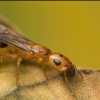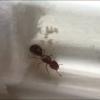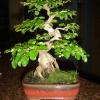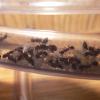Here is some research I am working on Turns out it was mixed between an American Yellow Meadow Ant and Lasius flavus
Leaf cutter ant
Leafcutter ants eat a fungus that they cultivate in underground gardens. They grow the fungus by feeding it a compost made from leaves they cut. How they grow the fungus is They cut leaves from plants then they carry the leaves back to their underground nests and cut the leaves into small pieces then they inject the leaf pieces with a fungal secretion The fungus breaks down the leaves into an edible mushroom form why they grow the fungus the fungus breaks down plant polymers that the ants' digestive enzymes can't This makes the plants more nutritious for the ants. Leafcutter ants are found in Latin America and the Caribbean; they live in the forest floor and construct underground chambers. Leafcutter ants use vibrations to communicate with each other they can send vibrations through their jaws into the leaf, which travel down the stem to nearby nest mates
How to feed them
Give them leaves, that is it they do the rest on their own
Nest temperature
Leaf cutter ants prefer a nest temperature between 23°C and 26°C (73°F and 79°F), as they are accustomed to a very stable underground temperature in their natural tropical habitat, with minimal variation throughout the year.
Key points about leaf cutter ant temperature preferences:Stable temperature: They thrive in a consistent temperature range, with minimal fluctuations. Tropical climate: Since they originate from tropical regions, they prefer warmer temperatures. Underground nesting: Their underground nests naturally help regulate temperature.
Outworld temperature
Leafcutter ants prefer an outworld temperature between 24°C and 26°C (around 75°F to 79°F), as they are typically found in tropical environments with relatively stable temperatures; ensuring their nest area is also within this range is crucial for optimal health and activity.
Key points about leafcutter ant temperature preferences:Stable temperature: They thrive in environments with minimal temperature fluctuations.
Humidity
Leafcutter ants prefer a humidity level of 85–95%.
ExplanationLeafcutter ants are native to the tropical regions of South America, where they live in lowland shrubs and foliage. They thrive in environments that mimic their natural habitat, including the right temperature and humidity. When kept in captivity, the humidity level should be measured directly where the fungus is located. Cold surfaces can act as dehumidifiers, so condensation may form on the glass of an enclosure.
Cleaning Stuff should be the same as the Yellow Meadow ant
Could you guys also give me advice on what ant I should do next And advice on the Yellow Meadow Ant
Edited by ant1234, March 10 2025 - 4:59 PM.





















